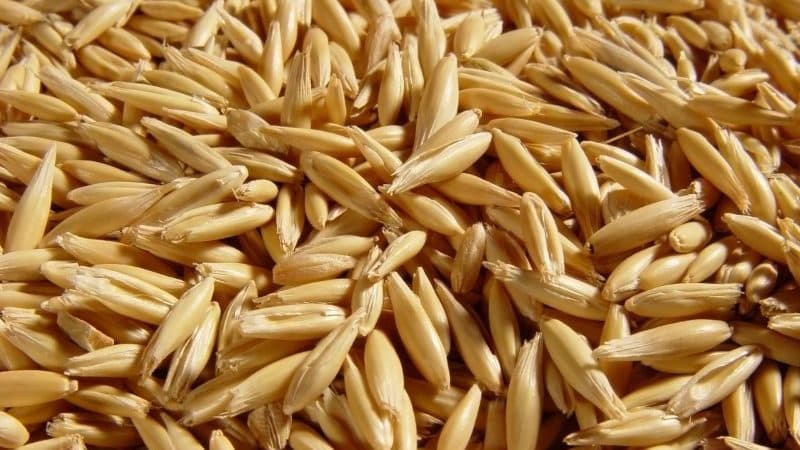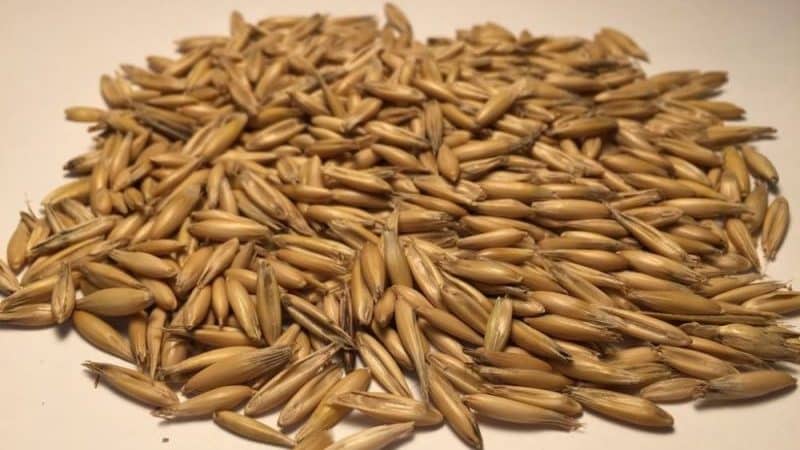What is feed oats and features of its cultivation
Over the centuries, people have found forage oats There are many applications, but the main area is feed. What are the advantages of a common grain crop, is it necessary to include it in the diet of animals, and how to grow it - we will tell you in the article.
What are feed oats
Feed oats, unlike food oats, are intended to feed livestock and poultry. The feed qualities of the cereal are determined by GOST - it is almost impossible to distinguish feed grain from ordinary grain by appearance.

History of appearance
Oats began to be processed in the second millennium BC. Its homeland is considered to be Mongolia and the northern provinces of China, but traces of it are also seen in Scotland, Denmark and England, where it was used as a food product during the Bronze Age.
The Romans and Greeks used it exclusively as fodder, but the ancient Germans and Slavs firmly established it in their diet, making baked goods, porridges, and jelly.
Description and characteristics
Oats are grown primarily for livestock, poultry, and pigs. Only 2% of grain is used in cooking, despite the fact that its nutritional properties are superior to many of our usual products. In general, culture remains undervalued.
It is grown mainly in the northern hemisphere. The farm distinguishes between its spring and winter varieties, as well as filmy and bare grain.
What is its advantage
Oats contain essential amino acids such as arginine, lysine, threonine, tyrosine, leucine and others.The culture is indispensable as feed for horses; it is the basis of their diet, which animals can consume in unlimited quantities. The price for it is significantly lower than for other types of feed grain - on average 7-9 rubles / kg.
Reference. Oats are a powerful source of energy. It must be included in the diet of animals employed in the household or regularly participating in competitions.
How is it different from normal
The main difference is quality. The standards for food and feed grains differ significantly. For feed, darkened grains, high humidity, a higher rate of contamination and foreign grain impurities are acceptable. Infection with ticks is allowed, but not higher than the first degree. However, the same requirements for smell and color are put forward to the forage.
Economic use
In addition to being used as feed, hay and haylage, oats are used in medicine to make medicines and tinctures used for hepatitis, diabetes, tuberculosis, asthenia and various diseases of the nervous system.
In cooking, oats are used to make surrogate coffee, oat milk, flour for bakery products, cereals and jelly. Kvass, beer, mash, and sometimes vodka are made from oats.
Chemical composition, microelements and calorie content
The compositional features depend on the environment in which the oats grew, but the general indicators of the components remain unchanged (the mass of the components is presented per 100 g of oats):
- proteins – 10.1 g, less than 15%;
- fats – 4.7 g, no more than 11%;
- carbohydrates – 57.8 g, including starch – 36.1 g, up to 45%;
- manganese, iron and zinc in approximately equal proportions (from 3 to 6 g);
- calcium, copper, sodium, etc.
Oats contain B vitamins, folic acid and vitamin E. The value of the grain is also given by an extensive list of amino acids, the quantity of which oats has no equal:
- arginine – 850 mg;
- histidine – 270 mg;
- isoleucine – 560 mg;
- leucine – 1020 mg;
- lysine – 550 mg;
- methionine – 230 mg;
- phenylalanine – 700 mg;
- threonine – 490 mg;
- tryptophan – 190 mg;
- tyrosine – 450 mg;
- valine – 790 mg.
The calorie content of feed oats is approximately 316 kcal per 100 g.
Who can be fed with forage oats?
Oat grain can be safely fed to horses, pigs, small and large cattle, and poultry. The organisms of all herbivores perfectly assimilate and digest this food. It can be made the main part of the diet, or it can be included partially.
Attention! Don't overdo it with oats for pigs: if the animals are raised for slaughter, it imparts some bitterness to their meat.
Features of cultivation
Daily monitoring is not required if you prepare the seeds and water the plants in a timely manner. You will also have to watch out for weeds.
Choosing a landing site
Oats are unpretentious and absorb minerals even from the most barren soils; they only tolerate saline soils poorly. The most successful option would be acidic soil with a pH value of no more than 5-6.
It is also important to maintain soil moisture for successful plant development.. Therefore, in regions with arid climates, it is better to provide a regular watering system.
Soil preparation
If beets or corn were grown on the site before planting oats, fall plowing is done; if other types of agricultural plants are present, regular plowing to a depth of 25 cm is sufficient.
If the soil acidity is too high, you will need to fertilize the soil with phosphate rock in a ratio of 40-60 kg/ha. Peat soil is fertilized with additives containing manganese, boron and copper at a rate of 20-25 kg/ha.You can use pyrite cinders in an amount of 300-400 kg/ha.
Seed preparation
Select for sowing dense, healthy seeds, without visible damage or darkening. Immediately before the planting procedure, soak the grains for 15 minutes in a 1% solution of potassium permanganate for disinfection.
Planting scheme and technology
The most favorable period for sowing in the ground is the end of April or the beginning of May.
Important! You should not delay planting even for a few days - this can reduce the yield by a quarter of the possible weight.
Oats are sown in narrow rows so that there are 4 - 5.5 million seeds per 1 hectare of field. The average recommended depth for burying seeds is 4 cm, but for light soils it increases to 6 cm, and in dry areas even up to 7 cm.
Treatment against diseases and pests
Oats are most often disturbed by smut and Swedish fly. Other pests and diseases are extremely rare. The most common methods of control:
- Autumn plowing. Prevents the proliferation of many pests, including stem flies. It is carried out at the end of August or the first half of September, to a depth of 20-22 cm, and in the spring 2-3 cm higher.
- Cultivation. Good prevention against stem pests.
- From the Swedish fly Such drugs as “Bazudin”, “VE”, “Zolon”, “KE” and other similar insecticides help well.
- Fertilizers. In the treated areas, the process of mineralization of organic residues is accelerated, and there are fewer pathogens of root rot in the soil due to the early coarsening of stem tissues. Phosphate fertilizers, for example, granular superphosphate in a proportion of 10-20 kg/ha, cope especially well with the task.
- Thermal treatment of seeds. Used to prevent the appearance of loose smut.
Features of care
You don’t need a lot of fertilizers - oats grow well without them. It is enough just to control the balance of nitrogen in the soil - the plant does not like it and due to excess it can bring a worse harvest. If nitrogen is still required, fertilize in a ratio of 70-90 kg/ha.
It is necessary to ensure stable soil moisture of at least 60% - oats constantly need moisture and cannot tolerate drought. If possible, the soil is loosened and harrowed.
Harvest 120 days after planting.
Read also:
We save ourselves from cholesterol with the help of oats.
Are rolled oatmeal, oatmeal, and oats the same thing or are there differences?
What are the benefits of oats for diabetes and how to use them correctly.
Tips and tricks for growing and using feed oats

If you are interested in a rich harvest, listen to professional advice:
- Sow oats crosswise (distance between rows 15 cm) or narrow row (distance 6-8 m).
- After sowing, rolling is carried out using ring-spur rollers.
- When a soil crust appears, harrowing is carried out - shortly before germination and during tillering, it is better to do it across the rows.
- The most successful predecessors for oats are corn, legumes and winter crops. Not desirable - beets, as they dry out the soil and require loosening and abundant moisture after use.
Conclusion
Caring for oats is simple; it is enough to maintain soil moisture and protect the plants from diseases. Growing feed oats can be treated with less scrupulousness than table oats, but we must not forget that animals also need high-quality food.
Oat forage is a source of protein, essential amino acids and energy for livestock and poultry.